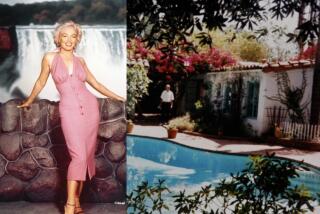Anyone who owns a monument can pretty much go about life as usual.
The Los Feliz Improvement Assn., an organization of homeowners in the area of old wealth and splendid architecture on the southern slopes of Griffith Park, held a genteel pep rally Tuesday night for a select group of its members.
The guests were people who now own houses built by such prominent figures as Walt Disney and Harry Chandler, former publisher of The Times, or designed by such luminaries as Frank Lloyd Wright.
They were invited to cultivate an interest in submitting their homes for designation by Los Angeles as historic-cultural monuments.
Leaders of the association are encouraging their members to do so as a means of documenting and protecting the values of the neighborhood.
Appropriately, the party was held in a home that already has become a historic-cultural monument--No. 123. It was the Lovell house, which sweeps out over a hillside from a barely noticeable porch on a crest-line cul-de-sac. It was designed in 1929 by Richard J. Neutra in the International style and represents one of the earliest uses of the all-steel frame.
Architecture historian Robert Winter rhapsodizes on its lines in “A Guide to Architecture in Los Angeles and Southern California.”
“The Lovell house, with its open, free-flowing plan, its modern materials and structural form, firmly established Neutra’s world reputation,” Winter wrote. “Today, almost 50 years after its construction, the Lovell house, in spite of slight alterations, looks new--the highest compliment.”
Compliments flowed just as freely from about 30 guests who arrived by caravan and were directed from a simple landing inside the front door down a cleanly angled staircase toward a wall of glass that perfectly framed the nearly silhouetted Griffith Park Observatory.
The guests chatted lightly over champagne and sandwiches until called to order just before dusk by Diane Kanner, history committee chairwoman for the association.
The high point of the program was introduction of the guests.
Among them were the owners of the house south of Los Feliz that was designated by the Smithsonian as the country’s best example of residential Art Deco, as well as the couple who live in Lloyd Wright’s Sowden home, the one with the Mayan-like interlocking block facade on Franklin Avenue.
“We’ve been in that house for about 14 years--working on it,” said Maury Mazur, who lives in the home designed by Frank Lloyd Wright’s son.
There was also Ronnie Clark Edwards, who owns the 1915 house built by the Bullock’s department store family.
Nini Mohi, who led the community campaign more than 15 years ago that saved the neo-Gothic architecture of John Marshall High School from demolition, said she didn’t have a historic home, but volunteered that the woman she bought the house from was rumored to be Louis B. Mayer’s mistress.
Estelle Massarik, who bought the Norma Talmadge villa 15 years ago, invited everyone to visit the house, where, she said, scenes from “Easy Rider” and “Too Much Too Soon” were filmed, and hundreds of actors used to gather.
Laurie Smith and her husband, Frederick, own the Travis Banton house, built around 1930 by the fashion designer of Paramount Studios.
“The most beautiful bar I’ve ever seen outside of a restaurant,” a friend of the Smiths offered.
After the introductions, a lawyer briefly described several tax benefits, including property- and income-tax deductions, for the owners of homes on the national landmark registry.
Then two representatives of the city’s Cultural Affairs Department, which administers the historic-cultural monument program, fielded a few tough questions.
Some of the homeowners wondered whether historic-cultural designation would affect their privacy. Others worried that, if they wanted to make improvements, it would become an impediment.
Frederick Smith, for example, said he might want to put in balconies because his bedroom gets so hot he has to go downstairs and sleep by his great bar in summer.
Others were concerned that they could be prevented from installing modern kitchens and bathrooms.
Nancy Fernandez, executive assistant for the Cultural Heritage Commission, assured them that anyone who owns a monument can pretty much go about life as usual and that the only major objection would come up if an owner wanted to deface or demolish a home.
“It’s just us,” Fernandez said of the people downtown.
What if “just us” is somebody else a few years from now, a woman asked?
Fernandez asked them to have faith.
Kanner, by the way, had a pretty good story that touched on faith.
It concerned the house they were in, whose builder, Philip M. Lovell, was a columnist for the Los Angeles Times. Lovell couldn’t get a bank loan because a radical design by an unknown architect named Neutra didn’t exactly inspire faith in 1929.
So Lovell went to his boss, Harry Chandler. Chandler made the loan personally, Kanner said. At Lovell’s invitation, in The Times, 15,000 people came to see the house when it was done.
More to Read
Sign up for Essential California
The most important California stories and recommendations in your inbox every morning.
You may occasionally receive promotional content from the Los Angeles Times.











